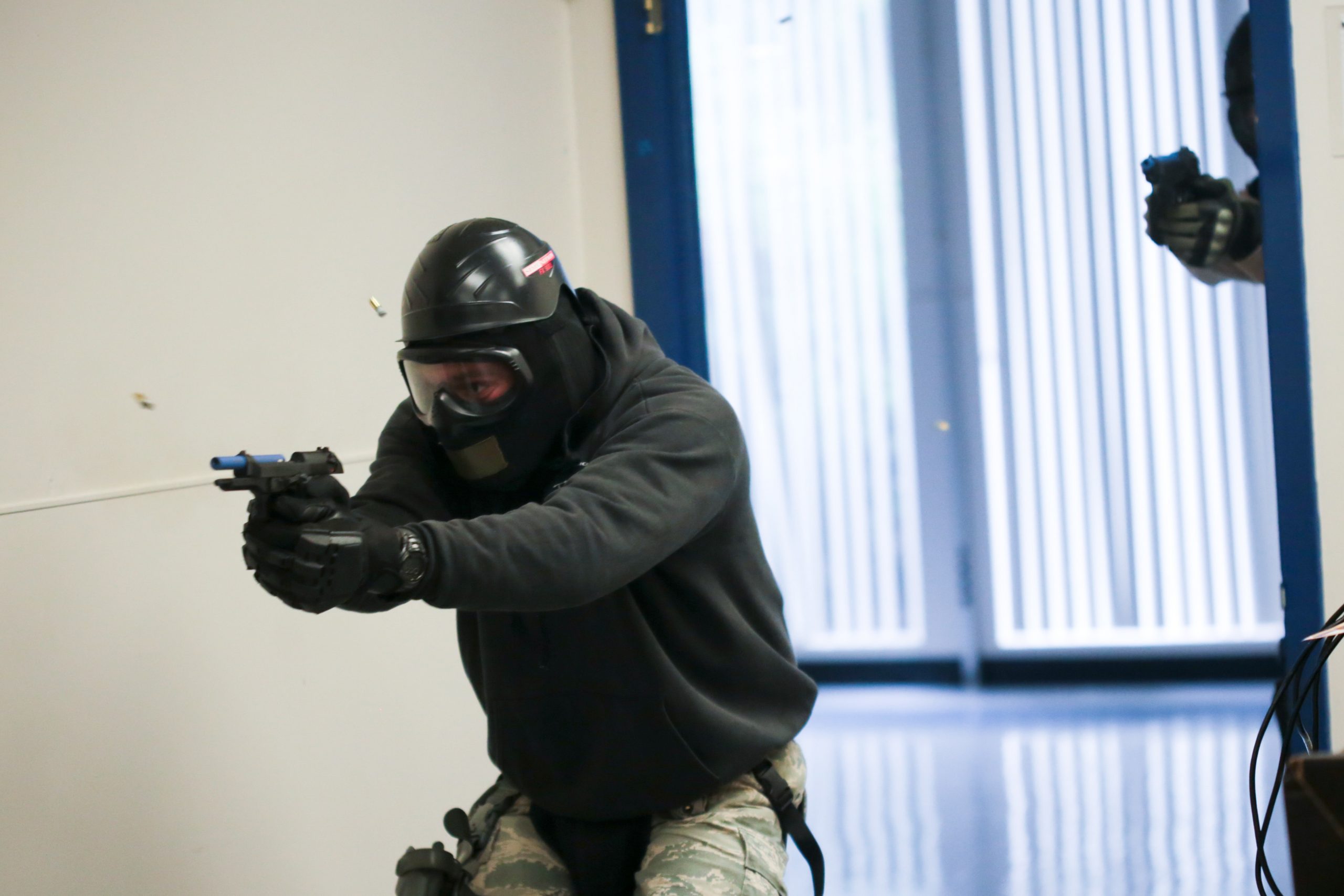Jordan Estrada 12.27.21
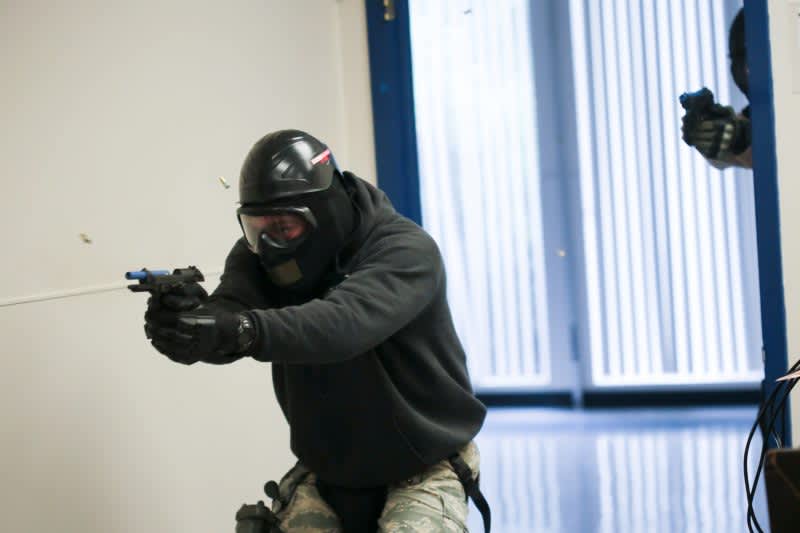
In last week’s post in our “Beginner’s Guide to Force on Force (FoF)” series, we discussed the various training rifle options for participating in simulated engagements. In today’s continuation of this series, we’re going to talk next about handgun options for training.
Just like with rifles, you have three options to choose from: guns that shoot paintballs, guns that shoot airsoft pellets, and conversion slides/dedicated guns for shooting simulation ammunition.
It’s important to note that you and your training partners don’t need to have the same exact training weapon platforms, and neither does your training handgun need to be the same type as your training rifle. Within a 30-yard engagement area, all the training weapons discussed in this series have generally the same performance capabilities. In the photo below, USMC trainees appear to be using a combination of converted M16 rifles firing simunition rounds, and a blank-firing M240:

The point is, it’s okay to mix and match.
An important rule to keep in mind when combining various training weapon types is to make sure that paintball and airsoft guns are limited to realistic magazine capacities — Nobody should be running around with 500 paintballs in their hopper (Although, I did participate in one scenario where we had a “machine gun nest” outfitted with a paintball gun with unlimited ammunition. It was fun to be the guy in the machine gun nest, and very educational to engage the nest with regular capacity weapons).
Keeping realism foremost in mind, let’s run through your options for simulated handguns, starting with:
Paintball pistols have seen an explosion in evolution and options recently, thanks in part to the invention of Pepperballs. Since this merger of paint and pepperspray, many manufacturers have put significant R&D into creating high-quality paintball handguns. The result has been a lot of mag-fed, reliable paintball sidearms, with the dual advantage of usability as either a training weapon or a less-lethal defense option.
As always, if you are training with a modified version of a real weapon (even if it’s a less-lethal weapon), you must take important safety steps to ensure that real munitions never find their way onto the training ground. We’ve outlined a comprehensive list of safety steps for Force on Force in part 1, but if you are going to be using a less-lethal paintball gun for Force on Force training, make sure that you:
- Don’t let real and simulated weapons and ammunition mix. Because FoF weapons closely resemble real firearms, it is absolutely essential that all real weapons and ammunition stay outside of the FoF area. Establish a sanitized “green zone” where only simulated weapons are allowed inside. Ensure that all real guns and live ammunition are kept outside of this area
- Blue means safe. In the FoF world, magazines, conversion bolts, and weapons themselves are painted or marked with “deep electric blue” to designate them as training weapons
You’ll also need to come up with a color marking and exclusion storage system to make sure your recreational paintballs and self defense Pepperballs never mix.
As long as safety measures are correctly employed, purchasing a high-quality paintball pistol can have multiple valuable uses. You want to select a paintball pistol that:
- Is powered by small 8-12 gram CO2 cartridges (you don’t want anything with a bulky external tank)
- Is magazine fed for realistic capacity and mag change practice
- Is as close to your actual real-life handgun as possible to create cross-over training value
Umarex has a nice collection of magazine-fed Paintball handgun replicas designed to mirror actual firearms:
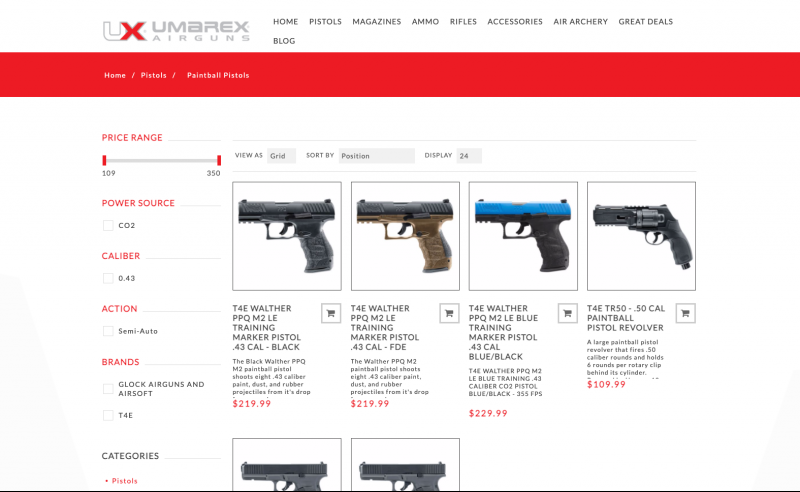
These include a very futuristic-looking paintball revolver (for all you wheel-gun fans):
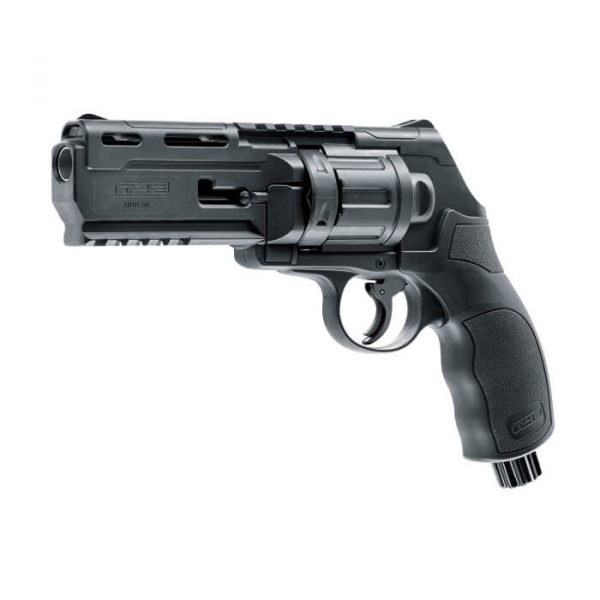
Umarex also offers a Walther PPQ in three colors — black, FDE, and “Force on Force” blue:

Lastly, Umarex offers a Glock 17 replica:
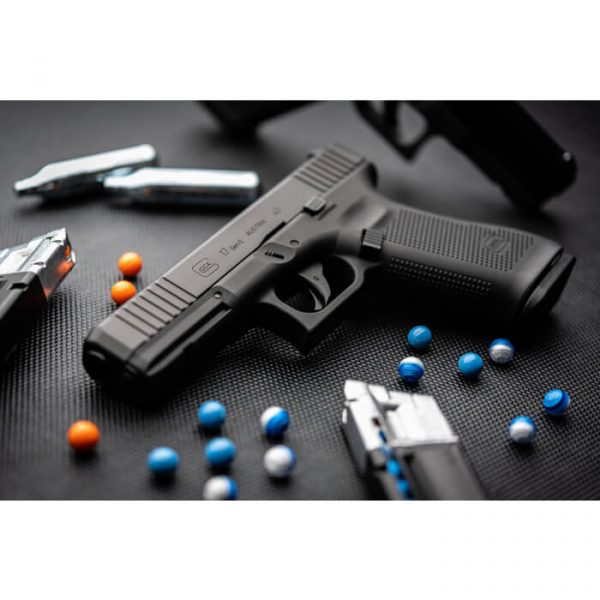
Picatinny rails on these training pistols allow you to attach weapon accessories, such as flashlights for night-time scenarios. All Umarex paint pistols are chambered in less common (but still widely accessible) paintball calibers — .43 and .50 caliber, as opposed to the recreational paint caliber of .68.
The Umarex handguns all feature a Feet-Per-Second (FPS) rating of 300-350, and most have a capacity of 8 rounds (the revolver has 6). As a general rule, paintball pistols will have a much lower capacity than other training pistols discussed here. This is due to the overly large size of paintballs, and the limitations of feeding them in a single stack magazine. 6-10 rounds seems to be the norm.
All the Umarex semi-auto simulated weapons include removable magazines which store both the paint and CO2. As discussed in Part 2 of this series, this may not seem like a big deal, but is actually a very important feature. Having a magazine that contains both CO2 and ammunition means that you don’t need to change out a CO2 tank mid-battle when you run out of air. Just as in real life, when you’re out of ammo, load a new magazine — using the same motions as loading a new magazine in any handgun. This allows you to employ the real-life manual of arms, and matches the muscle memory you’re hoping to build.

Another great brand for paintball pistols is First Strike, known for inventing the highly-accurate “first strike” paintballs. First Strike also offers a very interesting top-break revolver:

A good quality paintball pistol will cost between $200-$400. Expect to pay $30-$50 on individual magazines. It’s important to note that most paintball guns don’t come with orange tips or “Force on Force electric blue” markings. I highly recommend marking your paintball gun as a training weapon with either of these two safety color designations.
Handgun conversion kits allow you to shoot simulated ammunition from your regular handgun. A training conversion kit consist of a modified barrel and slide for your handgun that replaces the regular upper. In the picture below, a trainee is using what appears to be a modified Beretta M9. Note the blue barrel:

The main advantage of conversion kits is that they allow you to conduct Force on Force training with the same weapon you’d use in real life — great for building weapon familiarity and experience. The disadvantage is that there is a very limited number of makes and models with compatible training conversions, so you won’t find conversion kits for every handgun. In the previous article in this series about selecting a rifle, we talked about how an AR conversion bolt can work in any AR-pattern rifle. Unfortunately, pistols don’t have such flexibility, and a conversion kit must be specifically tailored to a make and model.
In general, conversion kits seem to be focused on full-size law enforcement duty weapons, such as the Glock 17 and SigP226. If you own one of the popular handguns that has a corresponding dedicated conversion system, this could be a great option. If you don’t, the advantages of this platform may be diminished.
The leader in pistol conversion kits for civilians is Ultimate Training Munitions (UTM) — and they have a distribution storefront with the NRA.
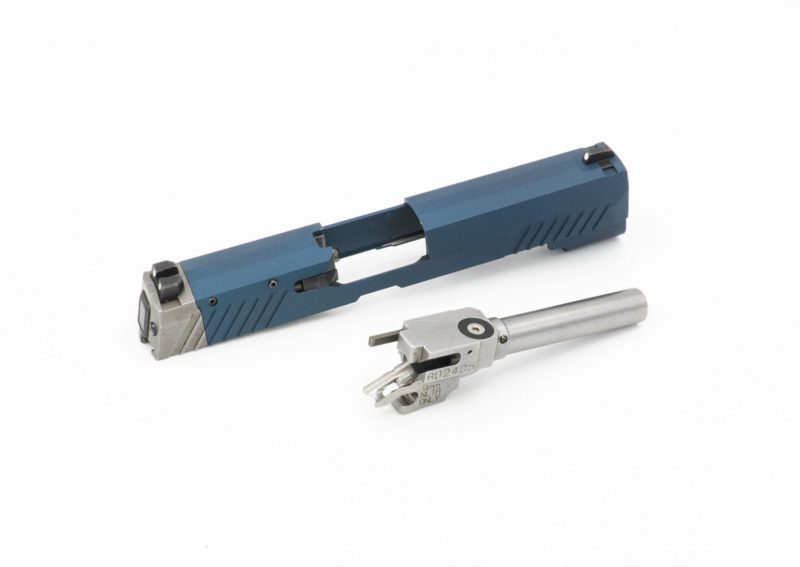
UTM ammunition travels at approximately 335 FPS, and costs $36 for 50 rounds of training 9mm, — and this is typical for the price of simulated ammunition. The downside of using any conversion kit for Force on Force is that training ammunition costs as much (or more) as real ammunition.
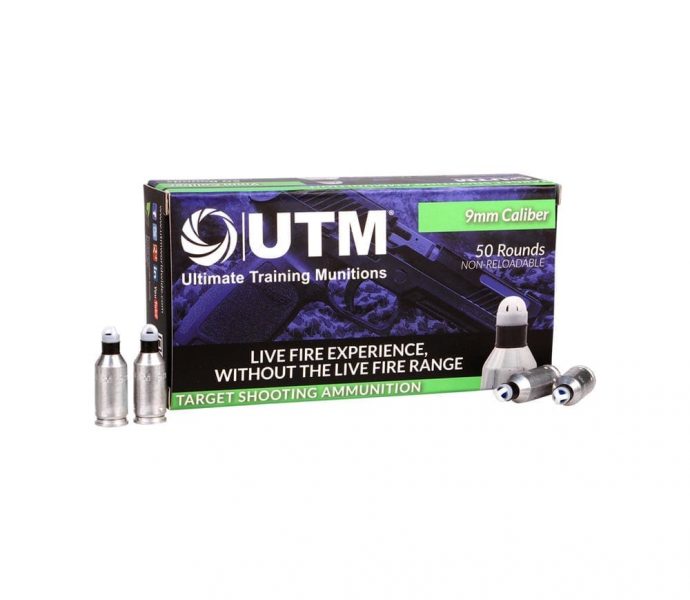
Photo: utm-nra.com
Handguns converted to Force on Force mode will operate with realistic blow back, casing ejections (as captured in our U.S. Air National Guard feature photo), and slide lock-back on an empty magazine. The only differences will be the non-existence of any significant recoil, muzzle blast, and noise.
Any good handgun conversion kit will include robust safety features to prevent a live round from chambering and firing when the conversion barrel/slide is installed. In the case of UTM, their handguns feature “a unique chamber profile that will not allow the standard host weapons caliber “Live” ammunition to completely chamber, therefore holding the weapon out of battery, making the weapon inoperative:”
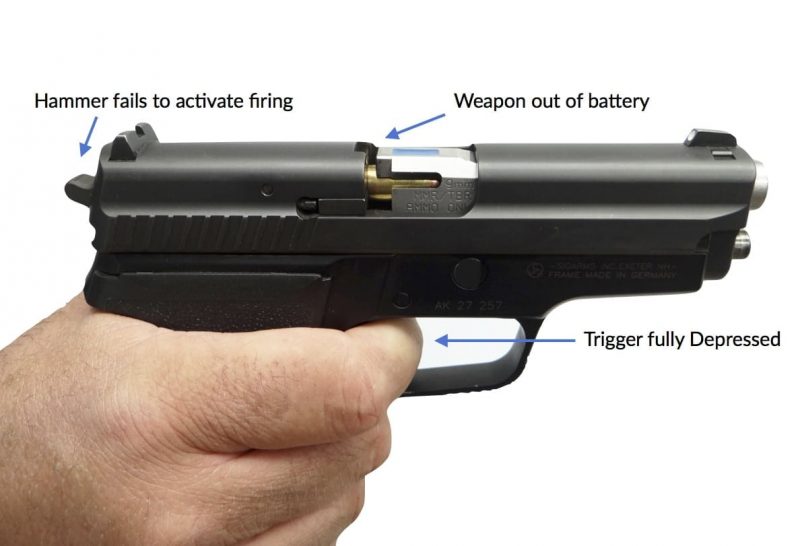
Photo: utmworldwide.com
It’s important to note that none of these safety features work if you forget to install the training conversion barrel and slide. Since training with conversion bolts involve pointing and firing a modified real weapon at another person, it’s essential to follow the manufacturer’s safety rules, and follow our safety rules for Force on Force as outlined in Part 1 of this series.
A pistol conversion kit costs around $200-$300. You will be able to use your standard pistol magazines, but be prepared to pay regular-ammunition prices for practice rounds.
When looking at airsoft options, limit your search to CO2 and Green Gas powered pistols — you’ll want to stay away from anything spring-loaded or electric (“AEG”).
Of all the training handgun options listed in this series, the cheapest by far is airsoft. While high performance airsoft handguns can cost hundreds of dollars, you can also get a good quality model for as little as $50. I’ve had a $45 CO2 licensed replica of the SIG SP2022 for years now, and it functions perfectly as a training weapon:
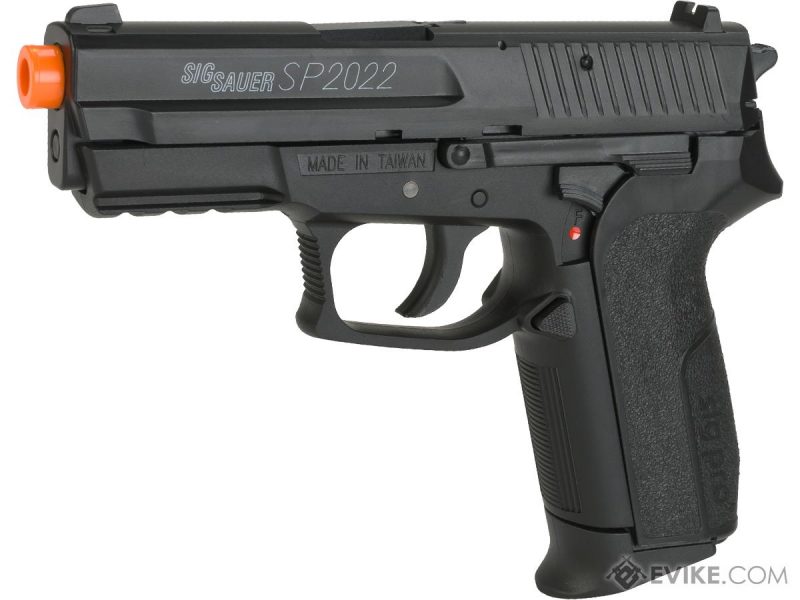
As an economy model, this pistol doesn’t feature high-end features, like gas blow back, or a slide that locks back on an empty magazine. However, it points, shoots, and hits just like a .22 pistol, and the 15 round drop-free magazine allows for realistic magazine capacity and combat reloads. I’ve been using this pistol for many years and found it to be very reliable.
If you’re interested in spending a little more for a heavier-duty, more realistic airsoft trainer, many high quality pistols can be purchased for less than $200.
For Sig fans, Sig Sauer has done a great job offering airsoft trainers along side their standard duty pistols. In addition to the licensed replica above, SIG also offers training models of the Sig P320 and the Sig P229.
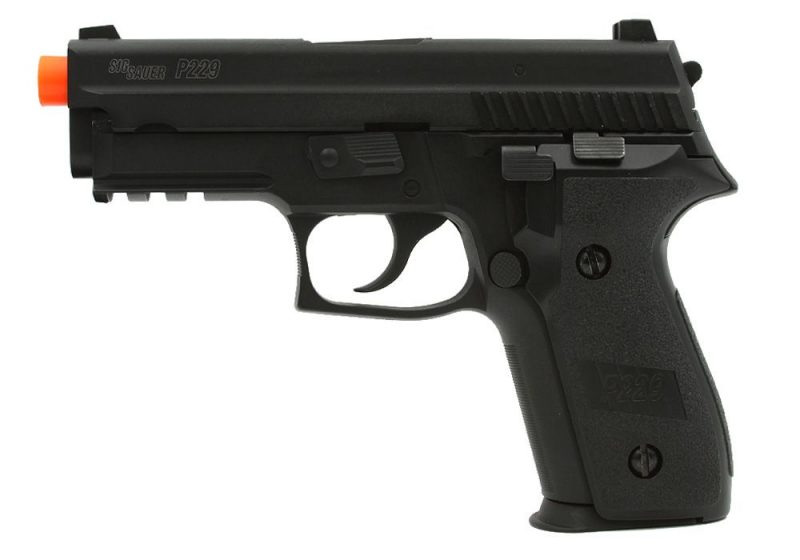
Just like the live version of the P320/M18, the SIG airsoft version features a slide cut-out for an optic, and Sig offers an airsoft version of their pistol reflex sight for $60:
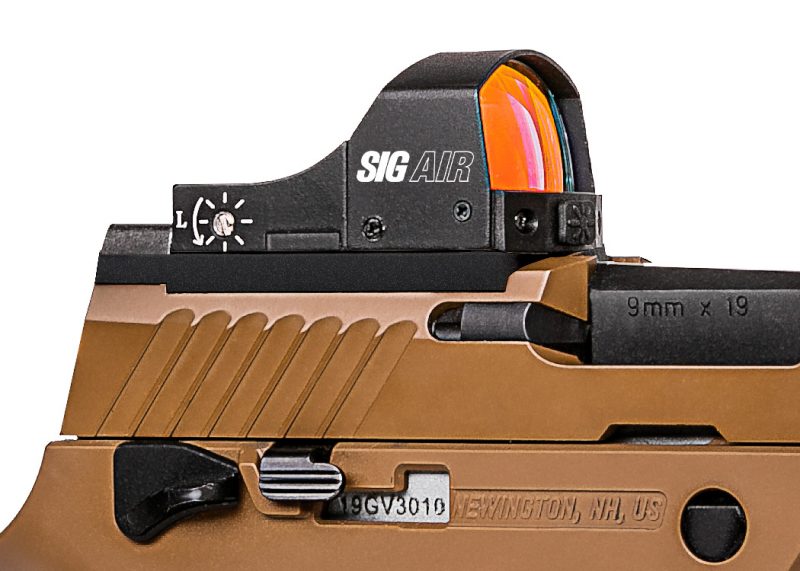
All Sig replicas feature full magazines, available for $39.99:

It’s important to note that not all airsoft magazines are created equal. Airsoft pistols can have either “stick magazines,” where the magazine only holds the pellets, or full magazines, where the magazine holds both the CO2 and the pellets. As stated throughout this series, magazines that hold both CO2 and ammunition are essential for high-fidelity training. While using a stick magazine pistol will work fine for the shooting parts, you’ll miss out on the valuable reloading component of realistic training. Stick magazines feel nothing like real magazines, and since the CO2 is inside the gun, eventually you’ll find yourself needing to reload gas — disruptive to simulations, and not an actual combat skill.
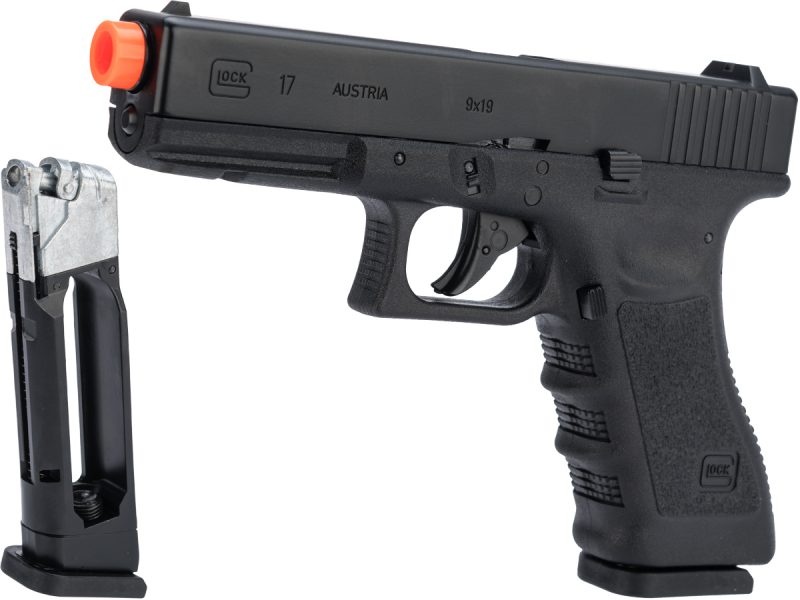

Gas-powered Airsoft training pistols generally cost under $200 and shoot at speeds around 300-400 FPS.
Conclusion
A good paintball, airsoft, or pistol conversion kit is useful for more than just Force on Force — it will also enable you to practice valuable handgun skills during times and in places where live ammunition isn’t an option. Many an hour can be spent training with an airsoft pistol in one’s basement. As the saying goes, “trigger time is trigger time,” and having a quality training pistol is extremely valuable if you hope to become proficient with your real-life handgun.
Now that we’ve discussed the various training weapon options, it’s time to put your gear into action. In the next part of this series, we’ll discuss how to set up or participate in an effective and realistic Force on Force training event.
